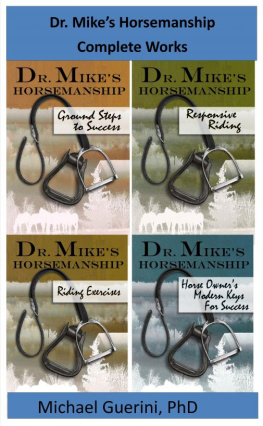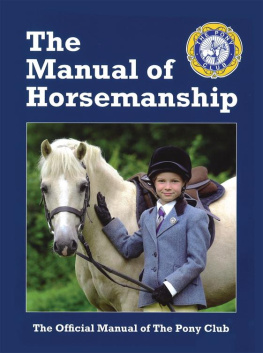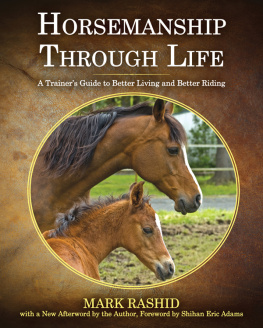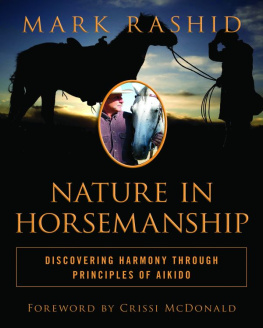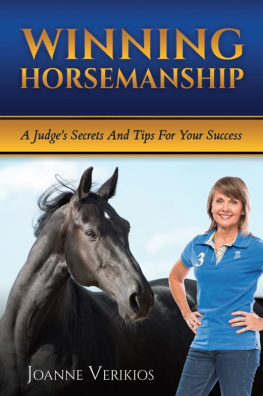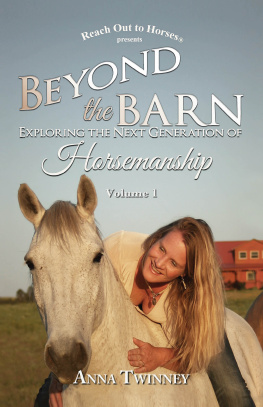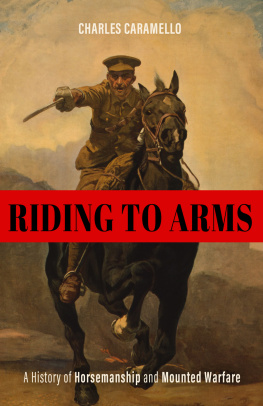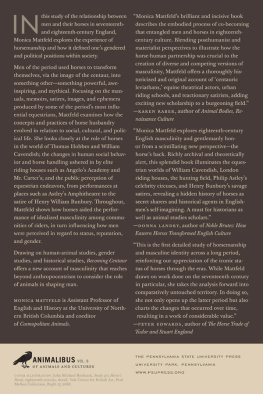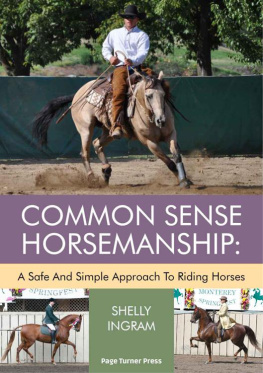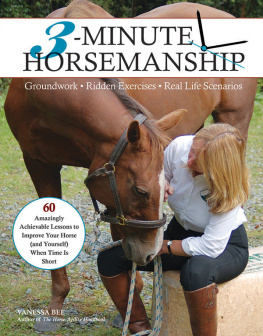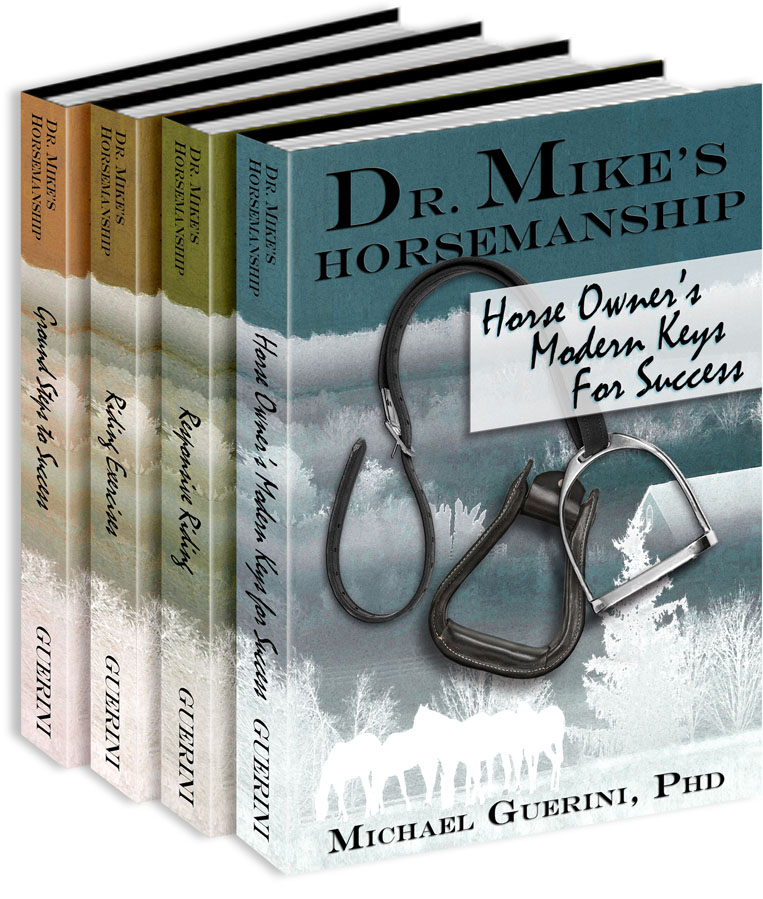
Dr. Mike's Horsemanship Complete Works
Published by Michael Guerini at Smashwords
Copyright 2014 Michael Guerini
Cover design by Ken J. Howe 2014
Smashwords Edition, License Notes
This ebook is licensed for yourpersonal enjoyment only. This ebook may not be re-sold or givenaway to other people. If you would like to share this book withanother person, please purchase an additional copy for eachrecipient. If youre reading this book and did not purchase it, orit was not purchased for your use only, then please return to yourfavorite ebook retailer and purchase your own copy. Thank you forrespecting the hard work of this author.
--------------------
TABLE OF CONTENTS
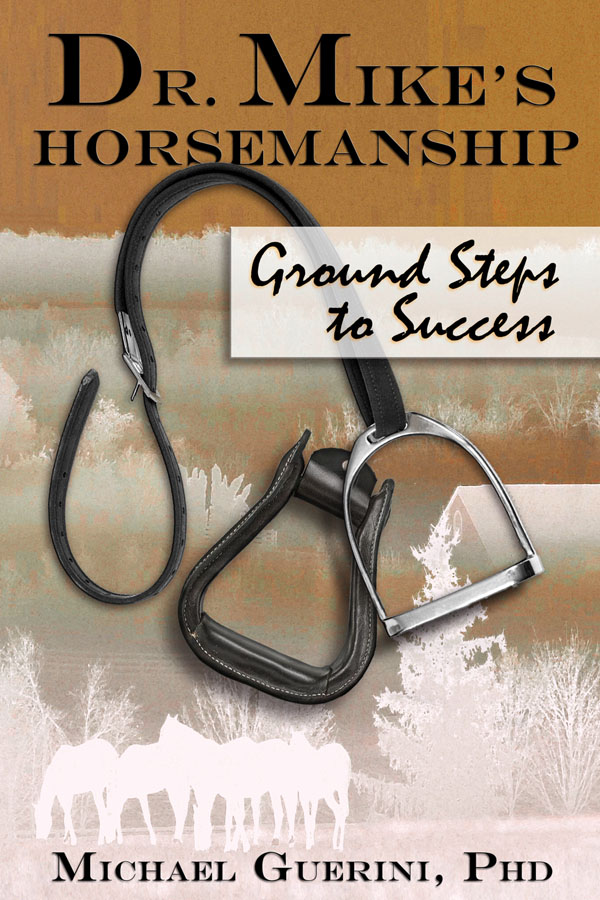
Introduction
From an early age, Dr. Mike gainedexperience in horsemanship by working with his family to trainyoung horses as well as working with Quarter Horse and Thoroughbredbreeders and trainers in California. During his college days, heworked for a variety of veterinary practices and gained valuableknowledge about horses.
I believe that a horse has a built-in desire toperform for his/her owner
These experiences have taught me that inmany instances the desire to work together with the human partneris confused by unclear signals. In other instances, frustratingbehaviors have been allowed to persist.
Our philosophy at Dun Movin Ranch is that wework together with the horse and rider to develop a solidrelationship based on trust and the 6 Cs of Horsemanship. All ofour training and clinics begin with groundwork focused ondeveloping this trust.
The 6 C's of Horsemanship
Experiences, observations, and greatconversations with horsemen and women around the country haveallowed me to develop the 6 C's of Horsemanship: Compassion, Confidence
Control, Calmness, Collection andConsistency.
Checking out your horse before riding
One of the most important things we need to dobefore we work our horses is to make sure they are healthy andphysically ready to work. How can we do this? First, we need tomake sure our horses are current on their vaccinations and thattheir feet are in good shape. To make sure our horses are healthywe should have them checked by a veterinarian every year or at thevery least every two years. Make sure your veterinarian checks yourhorses teeth. We need to make sure the farrier routinely trimstheir hooves and keeps their feet in good shape. I suggest youconsult with your veterinarian and farrier to develop a totalhealth management program for your horses.
Even with a total health management program, weneed to check on our horse before we do ground work or ride. Howcan we do this? We need to run our hands over our horses body anddown his legs and over his neck. We should feel for softness,bumps, and scratches. We should clean out his feet. We should alsolook at how our horse is holding his head and tail. Anything we seethat is not normal should be checked before we ride. If our horseis hurt or not feeling well the ride is going to have someproblems.
Reading your horses body language
Have you ever taken the time to sit on the fenceand just watch your horse? Do you know how your horse reacts when abird flies through his pen? Do you know how your horse acts whenanother horse walks by? Your relationship with your horse will growif you take the time to know how your horse acts when he is on hisown. Once you learn how your horse acts you will be able to startreading his body language when you work with him. Horses cannotspeak so they talk to us through body language.
Watch his ears and see if he listens to all thesounds, watch his tail and see if he swishes it all the time oronly when he is mad. Watch to see if your horse tenses up when heis upset. Watch and see if your horse paces when he is worried. Seeif he holds his head up high when he is in a new area.
Watching your horse will help you know what yourhorse is saying when you work together. If he moves his earstowards you then he is listening to you and your voice. If yourhorse is swishing his tail just like he does when the other horseis bothering him--- that is a clear sign he thinks you arebothering him. How do you learn what each movement means? You needto spend some time watching your horse and learning how he talksat home. Once you can understand his language then you can makesure he understands what you are asking him to do.
Some of the body language a horse uses to tellyou he is accepting what you are asking and that he is ready tolearn include dropping his head, chewing, taking deep breaths,moving his ears to listen to you and finally facing you and lookingfor direction.
Parts of the Horse body
As you look over your horse and make sure he ishealthy think about the four sections of your horse.
Section 1 is the head and neck.
Section 2 is the shoulders.
Section 3 is the barrel (rib section).
Section 4 is the hips.
Just like people, horses have many moving parts.None of us knows what each bone and muscle in our body is calledbut we all know they need to work together so that we can move.Horse anatomy is even more complicated so it is safe to say we areprobably not going to learn every muscle and bone in our horse. Ifyou think about the horse as having four moving sections as Idescribe above it is easier to think about how to move yourhorse.
For example, if you want to turn your horse tothe right the following must happen. The horses head and neck needto move to the right, then the shoulders, then the barrel andfinally the hips. Moving your horse is as simple as moving eachsection.
Pre-signal and preparatory commands
Last time I checked most of us were not mindreaders and none of our horses are mind readers either. As we allknow horses do not use words to talk---they use body language tocommunicate. So doesnt it make sense for us to also use bodylanguage? In my training and riding, I use verbal commands,physical (body language) pre-signals, and preparatory commands tohelp me communicate with my horses. My verbal signals are used intwo ways. First, I speak to my horse so that he knows to listen tome. Secondly, I give commands such as WALK and WHOA. Those areclear commands that mean something.
What is a pre-signal or a preparatory command?It is simply a way to tell our horses we are about ready to dosomething different from what we are doing right now. This is agreat way to let your horse prepare for a change and therefore hedoes not have to be worried about what you are going to ask next.For example as you are riding and want to turn to the right thefollowing actions by you are preparatory commands. Turn yourshoulders to the right, slightly increase your weight in the rightstirrup, and move your eyes to the right. Only after those 3preparatory commands do you move the reins to the right.
Pressure and release
We succeed in training by using pressure andrelease. The pressure tells our horse that we want him to move awayfrom that push. When we release (remove) the pressure that is thereward for doing what we wanted. Horses learn to move away frompressure so that they receive the reward and if we are clear aboutasking for movement the same way each time the horse associatesthat pressure with what he needs to do because he knows he will berewarded.
Tack
We all enjoy spending time at the tack shoplooking at the variety of items we can purchase for our horses.Many times, we see an item that claims it can cure this problem orthat problem. Very few items work as advertised so I alwaysencourage you to do your homework and seek advice andrecommendations for products. We always need to remember that ourhorse will work with us and that there is no magical tack that isgoing to solve the problem.
Next page
